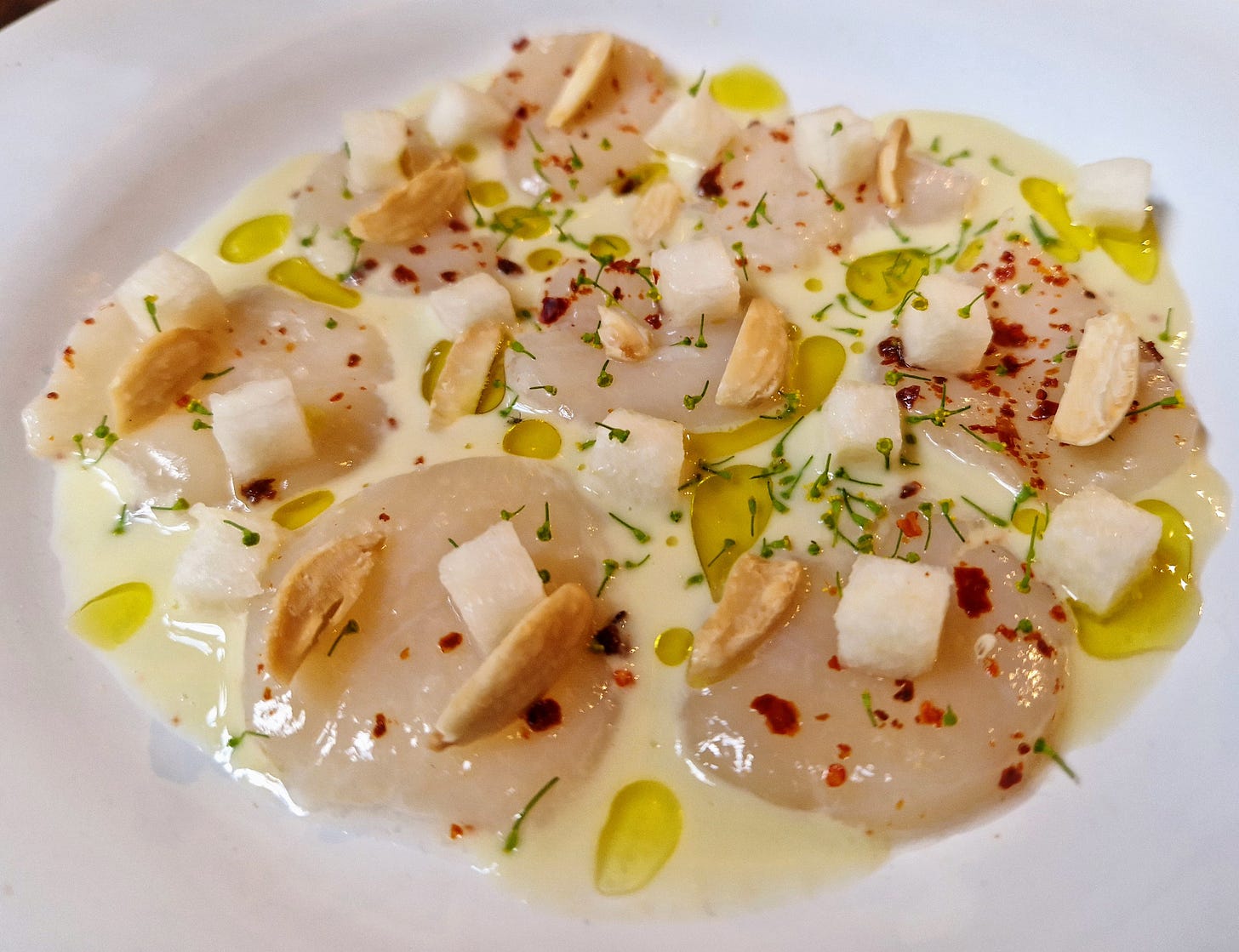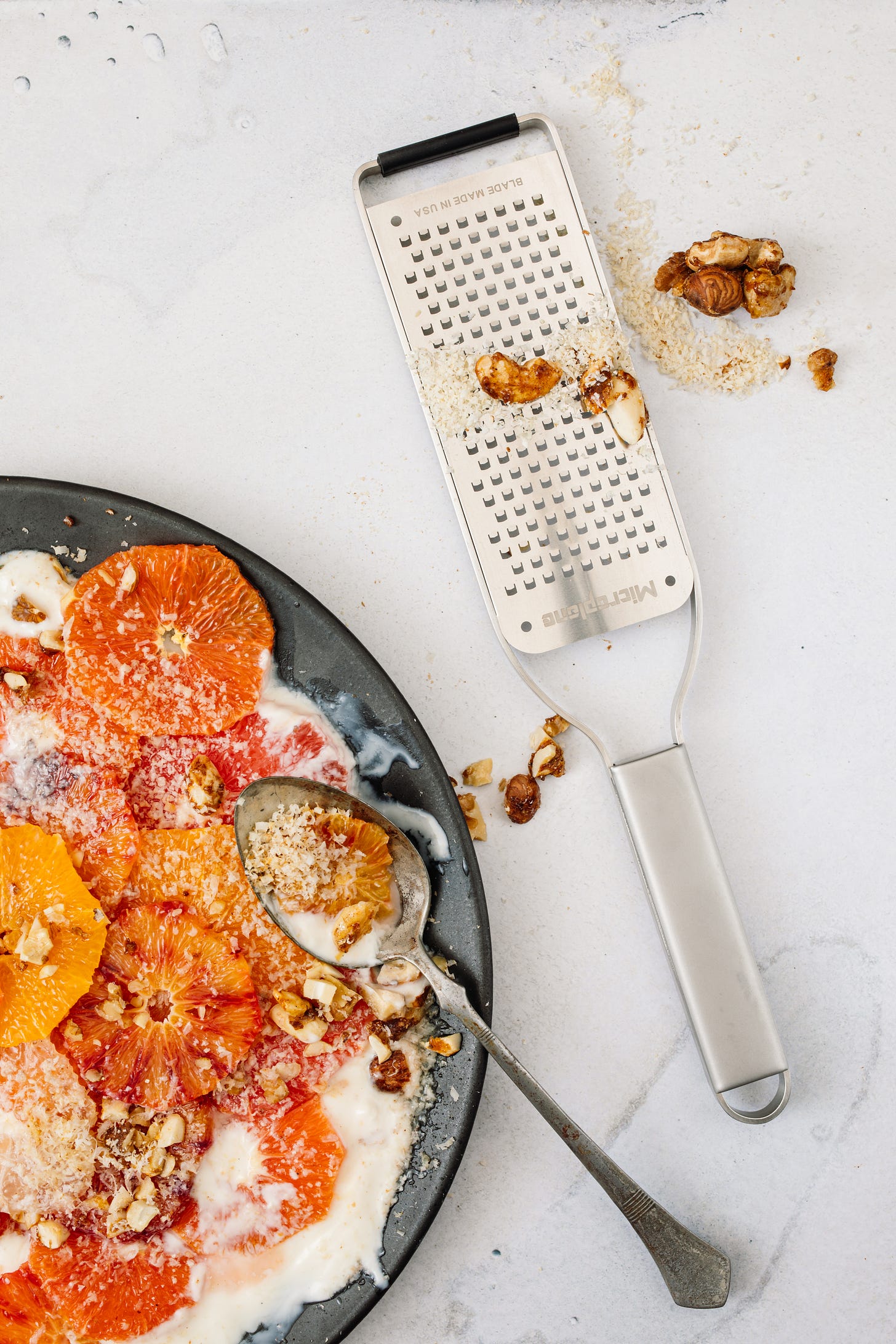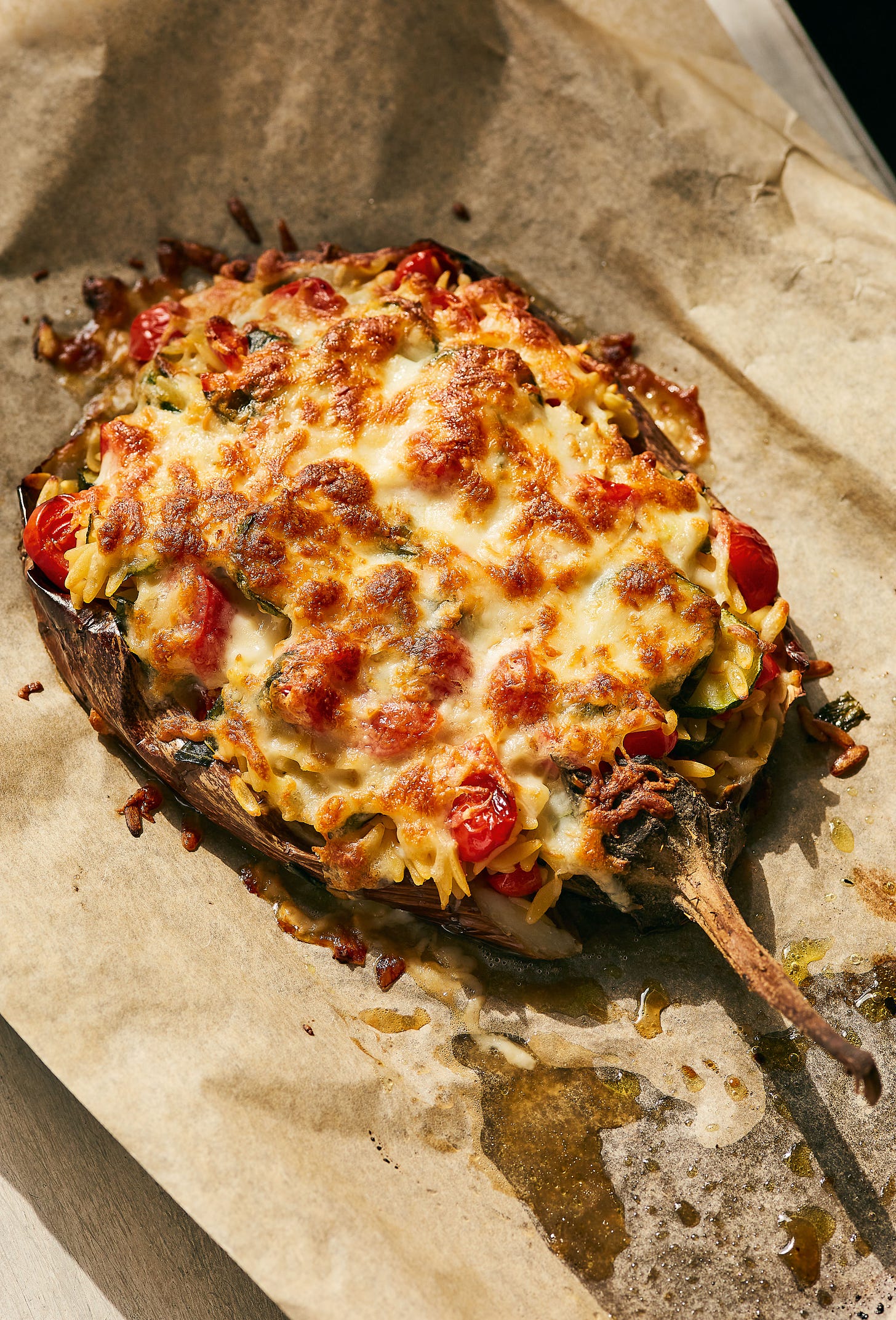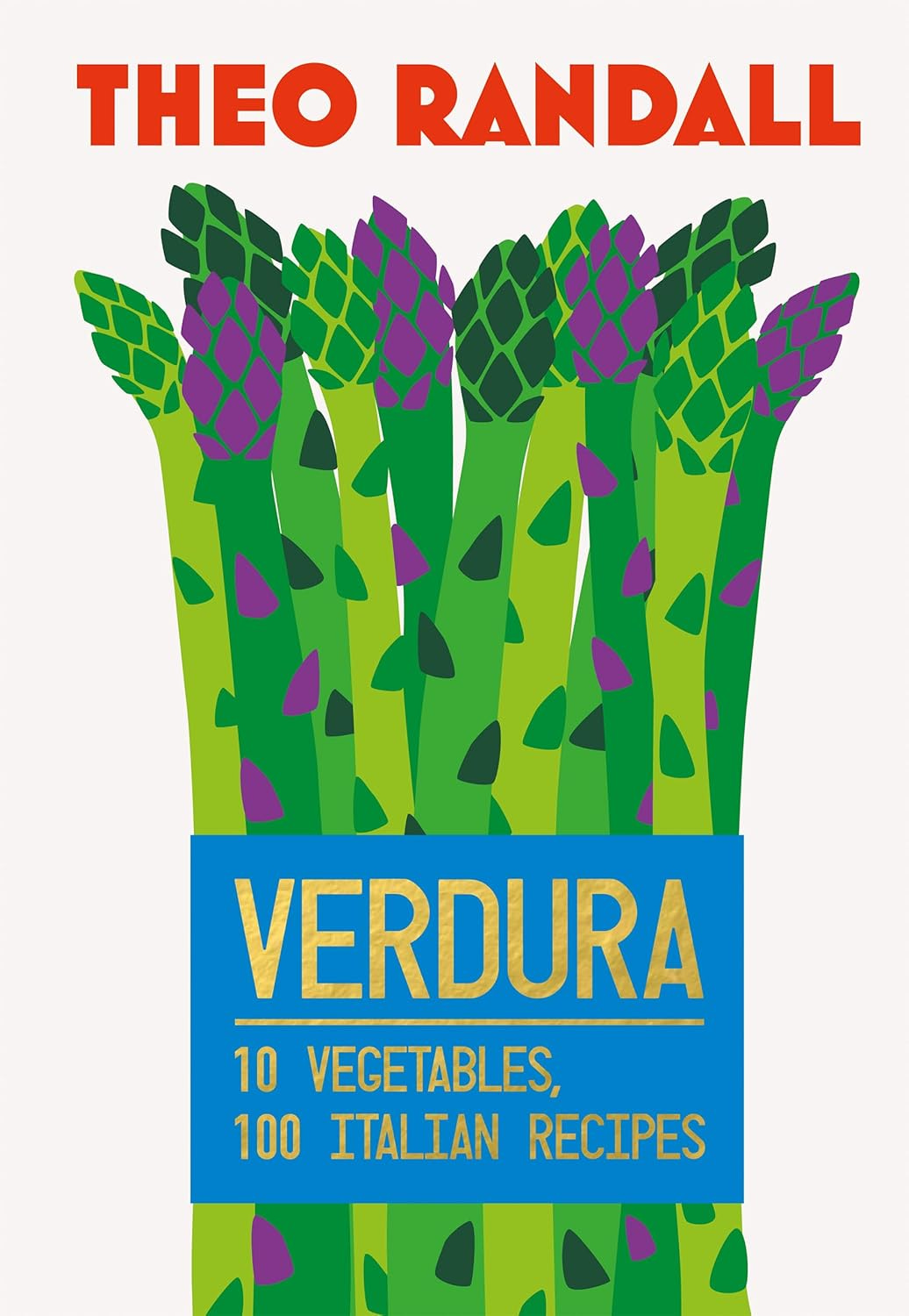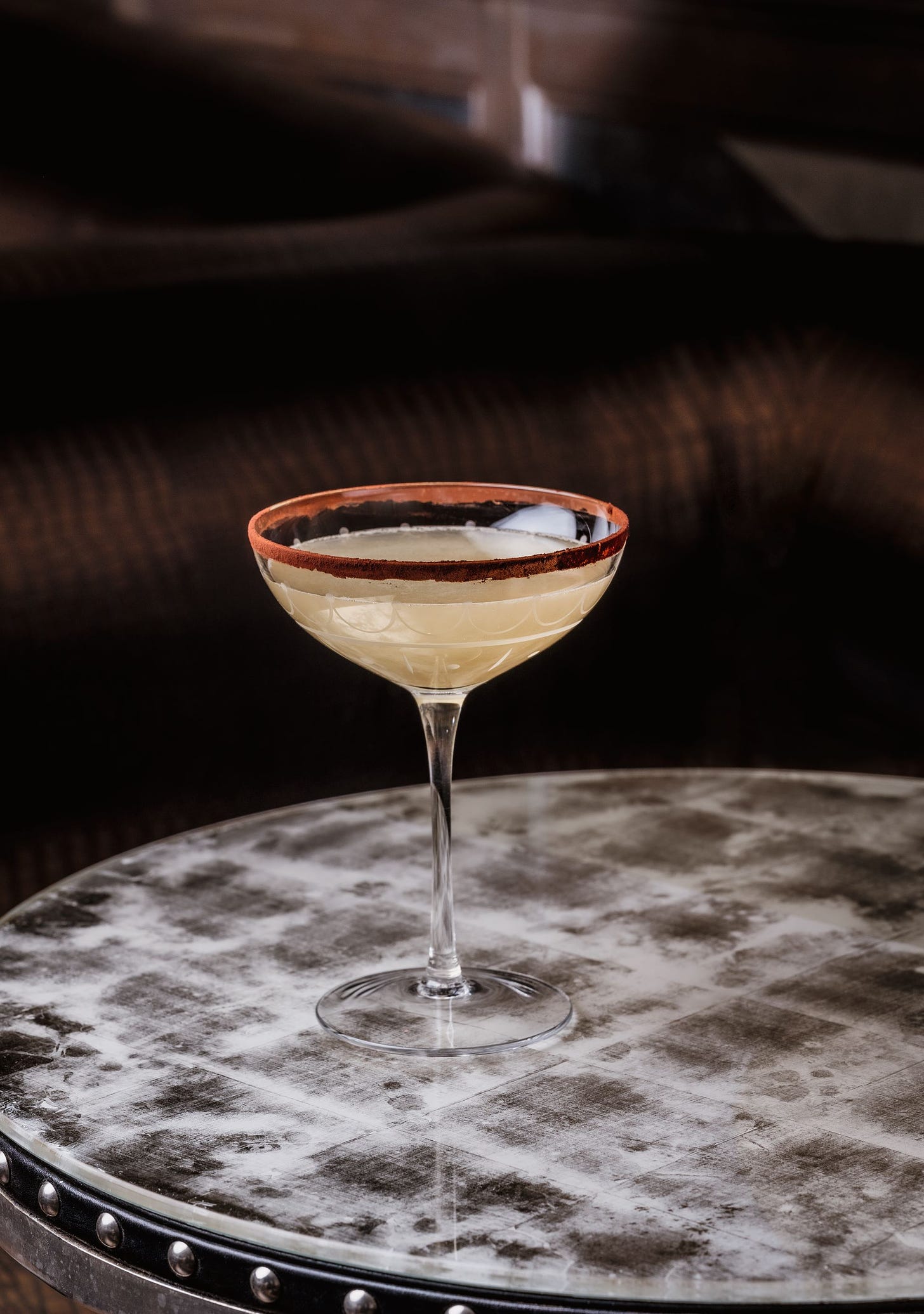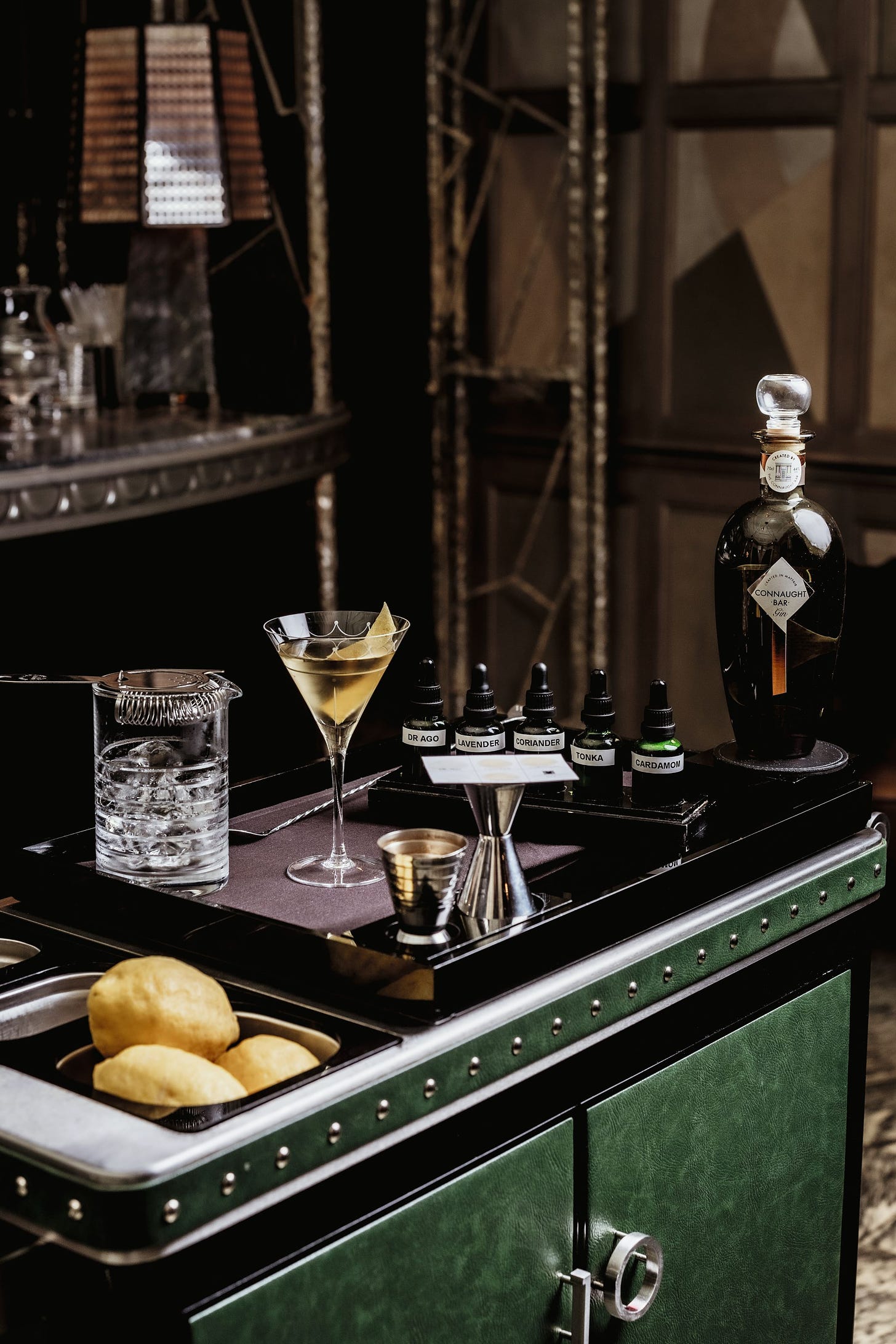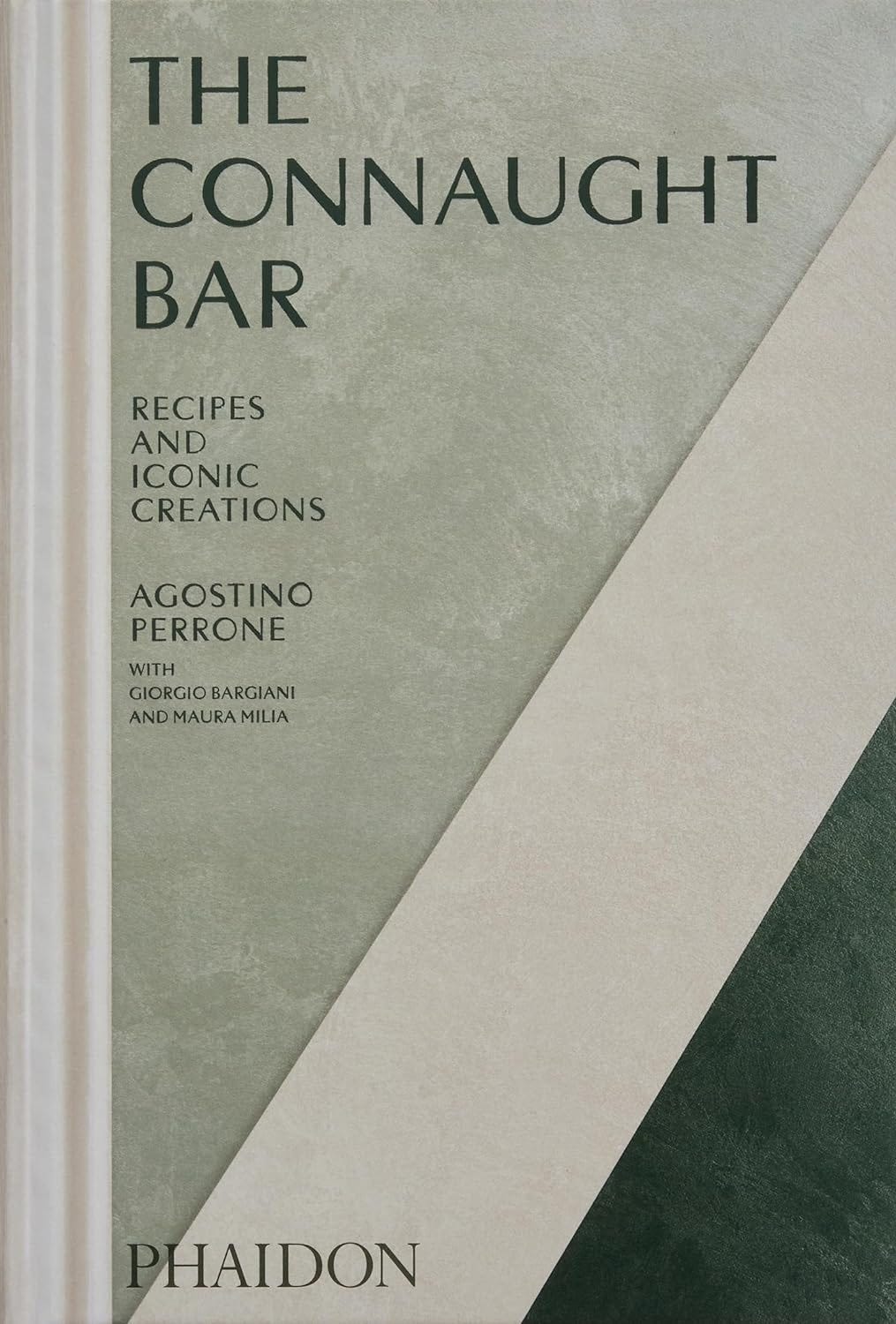Smashed: Something for the Weekend #2
cocktails from The Connaught, a Theo Randall recipe, what to order at Wildflowers restaurant in London and more
Something to eat
Scallop crudo, nashi pear, almonds, fennel pollen and olive oil at Wildflowers
I usually prefer my scallops seared but I was converted to the idea of eating them raw by this exquisite creation from chef Aaron Potter. The former head chef of Trinity and Elystan Street in London has just opened his first restaurant Wildflowers in Belgravia and the Mediterranean-inspired menu is full of big punchy flavours. Although the combination of the raw shellfish, pear, almonds, Ajo Blanco (chilled almond soup) and a touch of Aleppo chilli was more subtle and lighter than much of the menu, it still delivered bags of flavour and texture. Other highlights included some wicked Gorgonzola stuffed gnocco fritto (even if they were ambitiously priced at £4.50 a pop - they are basically a mouthful) and a rustic cuttlefish and octopus fideua with alioli that was perfect autumn comfort food.

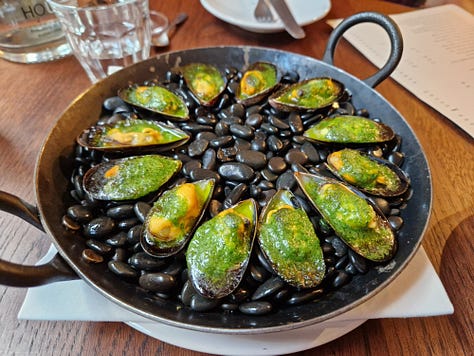
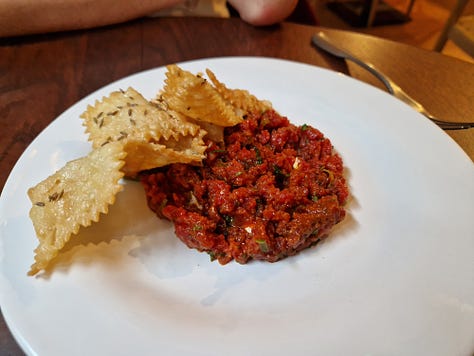

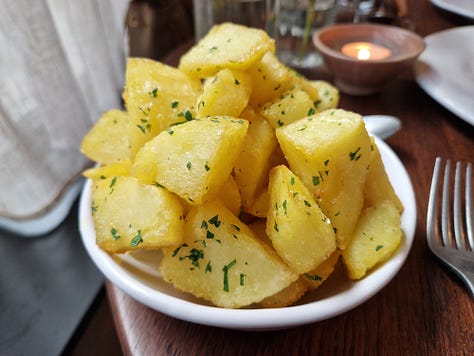
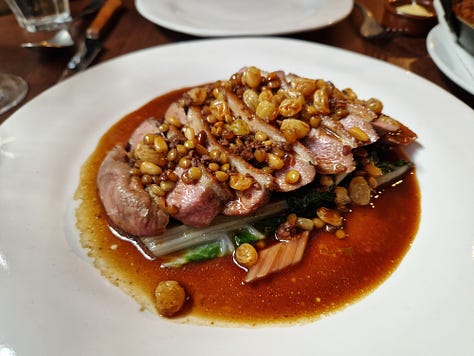
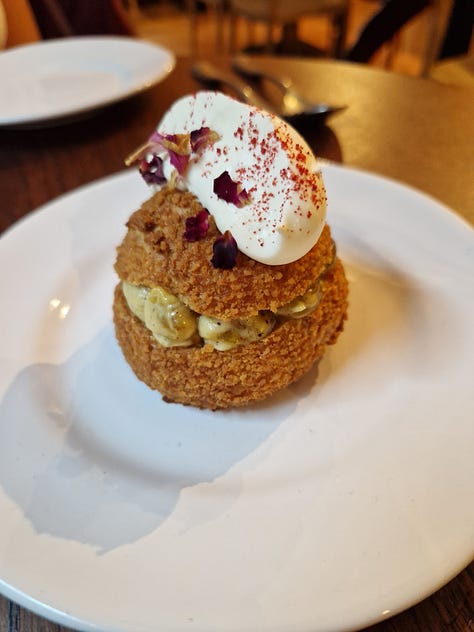
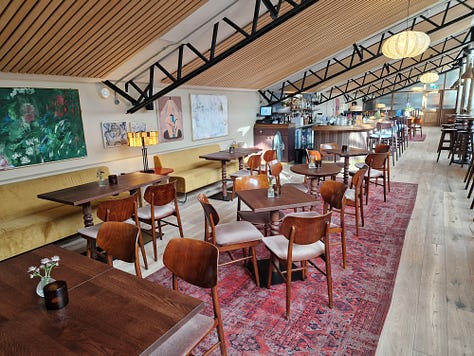
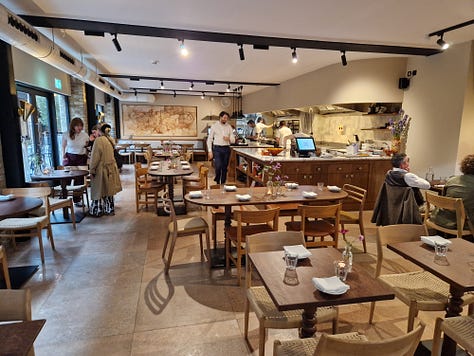
Potter’s partner in the business is interior stylist Laura Hart so it’s no surprise that the room is an attractive space to dine in (my pictures don’t do it justice). The kitchen is not so much open as fully integrated into the dining room; it feels like you’ve been invited round to someone’s rather lovely country house kitchen for dinner. Upstairs there’s a big bar partly open to Newson’s Yard, the converted 19th-century timber yard in which the restaurant is located, where you can drink European wines and eat cicchetti-style bar snacks. There’s also seating outside the restaurant on the covered walkway.
Bar snacks aside, there’s just one a la carte menu on offer with mains topping out at a not unreasonable £34 for some Cornish duck, perfectly cooked over coals and served with golden raisins, pinenuts and sherry. While a meal at Wildflowers won’t break the bank, it will be interesting to see if they decide to offer a set lunch menu to entice a few more daytime diners in.
(I dined as a guest of the restaurant)
Wildflowers, Newsons Yard, 57 Pimlico Road, SW1W 8NE
wildflowersrestaurant.co.uk
Something to buy
Microplane Professional Series
What did we do before the Microplane? Don’t get me wrong, I love my old box grater and still use it all the time, but you just can’t beat the delicate snowfall of Parmesan fluttering down on your penne al'arrabiata that you can only achieve with a Microplane. I’ve had my fine blade grater for more years than I care to recall and it’s grated an incalculable amount of ginger, garlic, cheese, lemon zest, lime zest and goodness knows what else. They are hardy kitchen tools but eventually, they do need replacing.
So hurrah for the new Microplane Professional Series. They look dead smart with their stainless-steel frames and razor-sharp blades, and matt chrome-finished handles. There are six to choose from (or if you’re really keen, collect) including a zester, fine coarse and extra coarse blades, a ribbon blade for medium thin slices of vegetables, cheese, fruit or chocolate and a large shaver for wafer-thin shavings of all of the above. Whatever you choose, they’ll make you feel like a real pro chef in your home kitchen. Just don’t shout ‘service’ at your better half after you’ve added that final flourish of finely grated lemon zest to their risotto, you’ll never live it down.
RRP £36.95. Stockists: John Lewis, Selfridges and Borough Kitchen
Something to read
Vanilla Black, Substack
Have you heard the one about the experimental vegetarian restaurant in York, an imaginary chef and Uri Gellar? No? Then you need to catch up with Vanilla Black, former chef and restaurateur Andrew Dargue’s quirky and funny weekly Substack that relates the trials and tribulations of being an independent restaurant owner.
It could be a book or a sitcom, but actually, it’s perfect as a Substack. Lucky you, you’ve got 20 editions to catch up on that tell the story of Vanilla Black the restaurant, beginning with its prehistory in the year 2000. Dargue, who at the time was a catering college lecturer and his wife Donna, a nurse, started a catering business called Collander supplying ready-prepared vegetarian dishes to restaurants, hotels and pubs. The rest is history, or it will be once Dargue has finished writing it. Spoiler alert, the story of Vanilla Black the restaurant ends in London in September 2020 - that’s a lot of Substacks to look forward to.
Subscribe at substack.com/@vanillablack
Something to watch
Chef’s Table Noodles
Following on from the very enjoyable Pizza season of Chef’s Table, the premier foodie documentary series turns its attention to noodles in all (well, some) of its forms. Chefs featured in the four-part series are pasta Jedi Evan Funke from Los Angeles; Guirong Wei, a pioneer of Shaanxi cuisine in the UK with her restaurants Xi’an Impression and Master Wei; Peppe Guida of Michelin-starred Antica Osteria Nonna Rosa in Vico Equense in Italy, and Nite Yun of Cambodian restaurant Lunette in San Francisco’s iconic ferry building.
Chef’s Table can be a little po-faced and over-serious at times, but it remains a must-see series for anyone interested in world cuisine. Season 7 of Chef’s Table has also been announced. It will air on 27 November and returns to the original format of profiling a diverse group of chefs that this time will include Kwame Onwuachi, the Top Chef alumni whose restaurant Tatiana By Kwame Onwuachi in the Lincoln Centre was named the number one restaurant in New York City by The New York Times two years running.
Look out for Chef’s Table: Legends in 2025 which marks the 10th anniversary of the series. Featured chefs are yet to be announced. I have honestly not heard a peep so I could be completely wrong about this but Alice Waters, Thomas Keller, Rene Redzepi and Fergus Henderson seem like obvious contenders as iconic and influential chefs. Watch this space.
Something to cook
Aubergine stuffed with orzo, zucchini and tomatoes by Theo Randall
A new cookbook by Theo Randall is always a cause for celebration. For his fifth, ‘Verdura’, Randall has chosen to focus on 10 of his favourite vegetables with 10 recipes for each. An interview with Randall about the book and his career will appear in Smashed very soon, but in the meantime, here’s a recipe to try this weekend.
‘A couple of summers ago we went to Ibiza with a group of friends. We had great food, as one of the group had done some serious restaurant research beforehand. Out of all the dishes we ate, a simple baked aubergine was one of my favourites. I loved the way the aubergine’s texture was so much part of the dish, and the cheese on top (they used tetilla) had a lovely creamy taste. This is my version. I have used smoked scamorza, as I find it brings out the flavours of the aubergine more. If you have a BBQ, try cooking the whole aubergines on it for a really authentic smoky flavour.’
Serves 4
4 large aubergines (eggplants)
3 tbsp extra-virgin olive oil, plus extra for greasing
6 medium courgettes (zucchini), sliced into 1cm (1⁄2in) rounds
1 garlic clove, finely sliced
6 basil leaves
250g (9oz) dried orzo pasta
1 mild red chilli, deseeded and finely chopped
200g (7oz) cherry tomatoes, quartered
250g (9oz) smoked scamorza, grated
sea salt and freshly ground black pepper
Preheat the oven to 200°C/180°C fan/400°F/Gas 6. Line a baking sheet with foil and rub a little olive oil over it.
With a fork, prick the aubergines all over and place them on the prepared baking sheet. Bake in the oven for 1 hour, turning each aubergine over after 30 minutes so they cook evenly.
Remove from the oven and leave to cool down on the baking sheet. Turn the oven down to 180°C/160°C fan/350°F/Gas 4. When cool enough to handle, take a sharp knife and score down the middle of each aubergine, about a third of the way through the flesh. Now pull open the flesh on each so you have 4 butterflied aubergines. Leave to one side.
Heat the olive oil in a non-stick frying pan that has a lid, then add the courgettes, garlic and a good pinch of salt. Cook, stirring frequently, for 5 minutes, then place the lid on top, turn down the heat and cook for a further 15 minutes. Add the basil leaves, season well and leave to one side.
Cook the orzo in a pan of boiling salted water for 2 minutes less than the packet suggests. Drain into a sieve and mix in a little olive oil. Place the orzo in a large bowl and add the cooked courgettes, chilli and tomatoes, seasoning with salt and black pepper. Spoon the mixture onto the open aubergines, making sure the aubergines are covered with the mixture.
Cover each aubergine with the grated smoked scamorza and place back in the oven for 15 minutes until the cheese is melted and golden in places. Serve immediately.
Extracted from Verdura by Theo Randall
£28, Quadrille
Click here to use an affilate link to buy this book and support Smashed.
Something to drink
Cocktails from The Connaught Bar
A cocktail at The Connaught Bar could cost you up to £2,210.00 (plus 15% service charge of course). You would however be drinking a ‘Silver Jubilee Rob Roy’ made with Macallan Silver Jubilee 1977 (bottles of which go for nearly £12k, although I’ve also seen them at £2.5k so what’s going on there?), 1970s Martini Rosso Vermouth and 1970s Angostura Bitter. More affordable options include the ‘Eclipse’ made with Roku Gin, Hundred Hills New Make Wine, 1757 Vermouth Rosso, Campari Bitter, Galliano L’aperitivo, Amaro Savoia and Cocoa Husk Milk for a mere £27 plus service.
Now The Connaught Bar book is available, you can stay at home and make the drinks in the comfort of your own home for a fraction of the price. Well, that’s the theory. In reality, many of the recipes in the book are as complex as a fine dining dish and as equally out of reach of the amateur. If you want to tackle all 100 recipes you’ll need such a well-stocked bar that you might as well open a five star hotel to house it all in.
It is however a beautifully put-together book with gorgeous photography by Lateef Okunnu. Leafing through will make you realise just how much time, effort and creativity you get for your £27 plus service. Some of the drinks rated ‘1’ or ‘2’ for difficulty are achievable and I’ve included two examples below. You may not go the trouble of knocking up batches of white peach puree and bee balm and cassia cordial to mix with Martini Vibrante to make an ‘Echo’ garnished with a crystal clear block of ice topped with small and large white chocolate discs, but there’s still plenty in the book that will inspire cocktail lovers, even if it is just to make a reservation at The Connaught Bar.
Latina Daisy
‘You may have experienced and loved many modern classics that fall under the drink category known as the Daisy – a sour cocktail sweetened with a liqueur or flavoured syrup. The Cosmopolitan, the Daiquirí and the Margarita (Spanish for ‘daisy’) are all Daisies. I crafted this Latina Daisy in 2008, to embrace the sensual experiences of Latin and Cuban culture – the colours, aromas, flavours and lifestyle. A classically crisp, fresh sour cocktail, it pairs dark chocolate liqueur with the crisp, fresh, lightly fruity character of white Cuban rum plus its distinctive notes of marzipan, citrus and allspice. This experience is heightened by the anise notes from the fennel seeds as well as the anise and vanilla dominant liqueur. Every sip of the Latina Daisy imparts a distinctive complexity, sophistication and richness to the palate. It can be served as an aperitif, digestif or simply as a delightful afternoon refreshment with a piece of rich, dark chocolate. My Latina Daisy was the winning creation at the 2009 Bacardí Legacy bartending competition.’
100% organic cocoa powder, for decorating the rim of the glass
1 lime half, for moistening the rim of the glass
10 ml (1/3 fl oz) Galliano l’Autentico
25 ml (3/4 fl oz) fresh lime juice
1–2 barspoons white caster (superfine) sugar
2 barspoons fennel seeds
50 ml (13/4 fl oz) white Cuban rum
20 ml (2/3 fl oz) dark crème de cacao
Spread some cocoa powder out on a plate. Prepare a coupette by moistening the rim with a lime half at a 45-degree angle and then dip the rim of the glass in the cocoa powder until coated. Pour the Galliano l’Autentico into the coupette to give the drink a silky texture and clear appearance. Combine the lime juice, sugar and fennel seeds in a cocktail shaker and lightly muddle to dissolve the sugar and express the character of the fennel seeds. By mixing the sugar and lime juice in this way, you get a crisper texture and flavour. Add the rum and crème de cacao and some ice cubes to the shaker, then shake and double strain into the prepared coupette.
The Connaught Martini
‘Whether it is the gin or vodka version, The Connaught Martini is an aromatized Martini that has been served following the same ritual since the day we opened the newly refurbished bar. It’s a distillation of the Connaught Bar ethos – it’s about approaching our guests. We want our new guests to get excited about what we do with our classic service, and we want our regular guests to feel comfortable and yet excited about trying something new.’
2 ml (1/2 teaspoon) bitters of choice
15 ml (1/2 fl oz) vermouth blend
75 ml (21/2 fl oz) gin or vodka of choice Lemon twist or green olive
To make a martini with a twist: Using a dropper, gently pour the bitters around the rim of a frozen martini glass or coupette. Combine the vermouth and spirit in a mixing glass filled two-thirds with large ice cubes and stir until well chilled. Strain into the prepared martini glass, raising the mixing glass high to add aeration to the drink and squeezing the lemon twist into the drink as the liquid passes into the glass. Garnish with the lemon twist.
To make a martini with an olive: Using a dropper, gently pour the bitters around the rim of a frozen martini glass or coupette. Prick the olive three times with a cocktail stick (toothpick) and let a little juice run out into the glass. Combine the vermouth and spirit in a mixing glass filled two-thirds with large ice cubes and stir until well chilled. Strain into the prepared martini glass, raising the mixing glass high to add aeration to the drink. Garnish with the olive skewered onto the cocktail stick.
About The Connaught Martini
‘At once the simplest and most challenging of all cocktails, a Martini cocktail reveals the mixer’s passion in every sip. At its best, the Martini transcends from mere cocktail to a concise and grand gesture that the work day is over, and the evening has begun. Anyone can make a Martini. Skill isn’t required to combine gin and vermouth in a glass. But to make a great Martini cocktail, even a better Martini cocktail than the one before, can be a lifelong pursuit.
Is the art in the proportions? It seems as if the measures are the starting point of any conversation about Martini mixing. Then comes the brands of gin, vodka and vermouth. Yes, great gin, vodka and vermouth are required. Yet there is so much more. One of the most important aspects of the best Martini cocktails is that they are personal expressions. They are as unique to the mixer as a painting is to an artist.
While most seasoned Martini cocktail drinkers tell the bartender exactly how they would like their Martini cocktail made, there is an adventurous group who put their faith and trust in the bartender. By saying, ‘as you prefer’, you taste the bartender’s personality, the bartender’s true talent. When I first came to London, I experienced Martini cocktails at the hands of the masters. Peter Dorelli at the Savoy, Salvatore Calabrese at 50 St. James, Alessandro Palazzi at Dukes, Giuliano Morandin at the Dorchester. These masters of effortless hospitality each had their own style. I wanted to create the same when I arrived at the Connaught Bar.
The Drinks Trolley
We prepare our Martini cocktails tableside because the Martini is arguably the most personal of all drinks served today. More than simply mixing, we prefer to take our guests on a journey to flavour perfection.
Our trolley is essentially a simple portable bar, and far from a new concept. Although drink trolleys were used back in the late 1800s, they exploded onto the scene when Prohibition was repealed in the United States in the 1930s. Restaurants in New York were not allowed to have bars that were visible to their guests, because it was thought a visible bar would be an irresistible temptation to otherwise temperate diners. To circumvent this law, bartenders stepped out from behind their hidden bars, loaded service trolleys and mixed diners’ drinks tableside. While this service style faded nearly into obscurity until the cocktail revival of the late 1990s and 2000s, we dearly love the added one-on-one time it affords us to spend with our guests. We keep a selection of guests’ favourite gins and vodkas plus bottles of our house blend vermouth in the trolley’s cabinet. On top are wells filled with olives and lemons as well as cocktail sticks (toothpicks). When a Connaught Martini is ordered, we go to the back of the bar to fill the mixing glass with ice and then we roll out the trolley, ready to perform.
The Bitters
The Martini cocktail is approaching its 140th birthday. Cocktail pioneer Harry Johnson added dashes of Boker’s bitters and curaçao to his Martini cocktail recipe in 1888. More often than not, orange bitters were the preferred addition during the drink’s first decades of popularity. Pedro Chicote, the father of modern Spanish bartending and author of many game-changing cocktail books in the 1920s and 1930s, enhanced his Martini cocktail with four dashes of Angostura Bitters. The truth is, the addition of bitters to this simple sip of gin and vermouth is the ideal place to add your personal touch, to create a Martini cocktail of your very own. Although most bars today omit the bitters, at the Connaught Bar we have created a series of bitters that allow us to personalize each Connaught Martini to our guests’ palates.
We present this option on our drinks trolley. Five little dropper bottles of bespoke bitters are the key to our version of the Martini cocktail. Dr Ago’s is a ginseng and bergamot bitters that is citrusy, woody and energizing. Dry lavender is both floral and calming with an aroma similar to rosemary and thyme. Coriander seeds impart a spicy, dark chocolate aroma that complements the botanicals in gin. Tonka bean blended with apricot kernels offers a sweet, woody aftertaste and provides a silky contrast to the gin’s explosion of flavours. Black cardamom is both minty and citrusy, adding an extra touch of spice to the drink. How do you make the right choice?
We have a business card-sized flavour mat printed with the names of each of the bitters. We place a drop of each in the appropriate square and let you smell each aroma. Then it is your choice which goes in and how much.
We gently pour about 2 ml or a scant 1/2 teaspoon of your chosen bitters using a dropper around the rim of a coupette. Because our bitters are diluted with spirit, they are not as intensely concentrated as an Angostura or other commercial bitters.
The Vermouth
Our vermouth is a blend, not a single brand or style. We blend an extra dry vermouth, a dry floral vermouth and a bianco vermouth together to achieve the right balance of dryness, floral notes and a hint of chocolaty sweetness. I selected the three vermouths from the older and better-known brands. Piquepoul and catarratto, clairette blanche, and other thin, acidic wines that are the base for making vermouth give the perfect balance against either gin or vodka. The botanicals, led by the wormwood that gives vermouth its name, accent the wine. Interestingly, many vermouth botanicals – orange and lemon peel, liquorice root, cinnamon and cassia barks to name a few – mirror those in the gin and thus flawlessly accent it. But no matter which vermouth you choose to use, it is essential to remember that vermouth is hardly stronger than a red wine and lasts only a little longer before its fresh and complex notes fade, leaving it a bit soft and flabby. Once you open a bottle of vermouth, be sure to keep it in the refrigerator. It will last ten times longer when refrigerated.
The Ice
The next important feature is the ice. The right kind of ice gives the drink
a silky texture, something you do not get from tap water ice cubes. We used to make our own ice from filtered water through a long and slow freezing process with a house-made insulated container to ensure that the ice blocks were crystal clear. Because the Connaught Martini became extremely popular, we now have a commercial supplier that makes ice to our specifications. We fill a mixing glass about three-quarters full with clear ice.
The Gin or Vodka
Good gin makes a massive difference in a gin Martini cocktail. A good vodka does the same for a vodka Martini cocktail. Generally, we leave the choice of gin or vodka up to our guest, as well as the choice of which brand. The spotlight is on our guest’s wishes not ours.
We stir our Connaught Martinis in front of our guest. It’s a big responsibility to stir such an important drink with precision – about 21 seconds – so it takes time before we let a new bartender who is properly trained and ready do this away from the bar. Using a Hawthorne strainer, we strain our Martini high above our head to give the drink some aeration as it falls into the glass and streams over the lemon twist (see below) to delicately express some of the fruit oils into the drink and to give the performance a little bit of dramatic flair.
The Olive or The Twist
If we use an olive, we spike it with three pinpricks to let a little of the juice run out into the glass, then we place it in the glass on a cocktail stick (toothpick). It is not a Dirty Martini, but it does allow some of the olive’s aroma and flavour to join with the rest of the flavours in the drink.
If we use a lemon twist, we use Amalfi lemons, which are delivered twice a week from Italy. (It is the same type of lemon that we use in its fresh state – not dried
– in the distillation of our house-made Connaught Gin.) We use a vegetable peeler to carve a large piece of peel with the least amount of white pith.
Combining this marriage of sights, sounds, flavours and aromas makes the experience of the Connaught Bar Martini both memorable and personal, worth revisiting more than once.’
Extracted from The Connaught Bar: Cocktail Recipes and Iconic Creations by Agostino Perrone with Giorgio Bargiani and Maura Milia
£29.95, Phaidon Press
Click here to buy the book using an affiliate link and help support Smashed.




